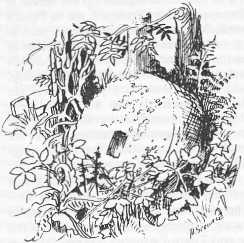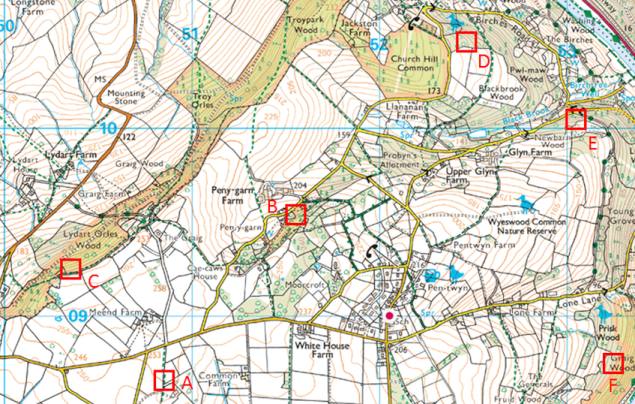Professor Gordon Tucker, who until recently owned Old Church Cottage and who was at one time a regular visitor to Penallt, is an industrial historian of considerable note and has published his research into the industries once found in this district. Some years ago he wrote a short piece on this subject for our parish Newsletter which forms the basis of this article, expanded with further material taken mainly from Professor Tucker’s other published work.
 Those inhabitants of Penallt whose families have lived in the parish for several generations are doubtless well aware of the industries which flourished here in the 19th century and earlier. Newcomers, however, might be forgiven for thinking of this beautiful parish as a peaceful backwater where farming and forestry have provided the only livelihood of the people. There is now little outward sign of the vanished industries, and indeed it has been remarkably difficult to trace their history.
Those inhabitants of Penallt whose families have lived in the parish for several generations are doubtless well aware of the industries which flourished here in the 19th century and earlier. Newcomers, however, might be forgiven for thinking of this beautiful parish as a peaceful backwater where farming and forestry have provided the only livelihood of the people. There is now little outward sign of the vanished industries, and indeed it has been remarkably difficult to trace their history.
The industry for which Penallt was long especially known was based on the local pudding-stone or jack-stone (breccias or quartz conglomerate to the geologist) and was the making of millstones for both corn and cider mills. The stone, which outcrops at places throughout the parish, was also used for building houses and walls, but was particularly suitable for millstones. The Penallt stones were already famous in the 14th century and continued to be quarried and exported up to the end of the 19th; there is no documentary evidence of the date when the industry ceased.
Not all of the disused quarries which dot the parish produced millstones; the following are the chief ones which are known to have done so, with their Ordnance Survey grid references given for anyone who may want to locate them:
A. To the west of Common Farm (SO 508086)
B. On the wooded ridge above Penygarn (SO 515095)
C. On the western boundary of the parish near Meend Farm (SO 503092)
D. In the wood above Barberry near the Old Church (SO 524105)
E. Above Birchtree Well on the lower part of Glyn Road (SO 530100)
F. In Graig Wood below The Generals (SO 532087)
(click for larger map)
At all of these sites unfinished or broken millstones can be found, and there are others in places on the wooded slopes where no definite quarries are to be seen; indeed, only Quarry B (known as Pwll Du or the Black Pit) and Quarry Care deeply excavated, the others being extensive working among the outcropping rocks. It is known that many of the stones were taken down to the Wye and loaded on barges for onward transport, and several can be seen at the bottom of the river, presumably dropped during attempts to load them.
Reputedly the last of the millstone quarrymen was Noah Hudson, who died in 1926 but whose widow lived on until 1942; in 1884 he was described as a millstone cutter but by 1914 he was working at the Redbrook Tinplate Works, so at some time in those thirty years the stonecutting seems to have come to an end. Professor Tucker has calculated, by analysing the occupations entered in the baptismal and marriage registers of the parish, that during the middle of the 19th century about fifteen men were regularly engaged in the industry at any one time; but some of the small farmers were also part-time quarrymen, such as William Reynolds, “yeoman and stonecutter”, who died in 1865.

Another industry which newcomers might be surprised to learn was once important here is the papermaking which was carried on along the White Brook between about 1760 and about 1885. There were five, or possibly six, papermills built on the brook, deriving their power from waterwheels driven by elaborate systems of leats, ponds and sluices, some of which can still be clearly seen. The two mills highest up the brook at Fernside (now Mill House) and Sunnyside (now Traligael) are in Penallt parish, and the others in Whitebrook. Mechanical improvements such as the replacement of waterwheels by turbines and the later substitution of steam power failed to halt the industry’s decline in the face of competition from larger mills closer to their markets, and in 1888 the plant at Fernside, the last mill in operation, was sold off. At least sixty papermakers are recorded in the registers of the two parishes, but the mills gave employment to many other people, mainly women and children, for the collection and “picking” of the rags used in paper manufacture. There are still memories handed down in Penallt of the rag-pickers and of the songs and stories with which they relieved the monotony of the work.
Much earlier still, beginning probably in 1595, the White Brook powered a wire-drawing mill, an offshoot of the industry centred at Tintern and up the Angidy valley. The only wire-works recorded appear to have been at the bottom of Whitebrook, probably using one or other of the derelict ponds at Whitebrook Farm and Tump Farm; but it is possible that others were established further up as well and that their works were later converted to papermills. The wire-drawing went on for over a century, ending in about 1720. Water power was, of course, the basis of many early industries including flour milling. There was a grist mill operating into the 1920s at New Mills, and another near the outfall of the Black Brook which was working in 1847 but apparently abandoned by 1900; and a watermill higher up this brook, which Major Probert believes was sited at Millbank Cottage, is mentioned in records of the 14th and 15th centuries.
Professor Tucker has identified no less than 35 embanked ponds on streams in the parishes of Penallt, Whitebrook and Redbrook, all but three or four of which seem to have been made for industrial purposes – if we count fish-farming as an industry. It was certainly important in the Middle Ages, and in the present century some of the old millponds on the White Brook were used for this purpose. In 1913 a Mr Markham David was recorded as having bought ponds for rearing trout and in 1926 Mr Christopher Browne of Fernside (Mill House) was described as a trout farmer. Later Mr John Crosse (of the family associated with Crosse and Blackwells) carried on the same business there, employing several Penallt men; he is still well remembered as having first provided car-parking space at the Parish Church, and he is buried there. In the 1960s Major Kenneth Taylor made the pond on the White Brook at New Mills House and used it for some time for rearing trout; and Mr jack Evans has recently restored the old pond on a tributary of the brook and is continuing the local tradition through an angling consortium.
Stepping briefly outside the parish bounds, mention must be made of Redbrook, for centuries an important local centre of industry. The two streams which flow through Upper and Lower Redbrook have the remains of thirteen ponds, several of which probably powered the blast furnaces of the copper and iron smelting industries which existed there in the 17th and 18th centuries. There was also a paper mill in the 17th century, a hundred years before the industry came to Whitebrook and Penallt, and at least two flour mills. But the most important development for the people of Penallt was the establishment of a tinplate mill in 1771. This business flourished and developed, with a change to steam power early in the 19th century and to electric drive in the 20th, until it went into a decline and was shut down in 1961 (causing also the final closure of the Wye Valley Railway).

Throughout this period the tinplate mill – which incidentally rolled the thinnest and highest-quality plate in the world – employed many men and women living in Penallt, who crossed on the ferried and trudged the steep roads home every day: long hours and hard, sometimes dangerous, work but a living when there were few other sources of employment in the parish. Most of the older families of Penallt had one or more members working at Redbrook, and the closure marked the end of an era. Nowadays Penallt people of working age, apart from the farmers who employ hardly any hired labour, have to go much further afield to find work – to Monmouth, Caldicot, Newport, or even to Bristol or London; the motorcar has made everyone a commuter. Tourism is now the Wye Valley’s main source of income, and the peace of its splendid scenery is again, after many centuries, free from the clangour and smoke of manufacturing industry.
[from: Penallt – A Village Miscellany]
